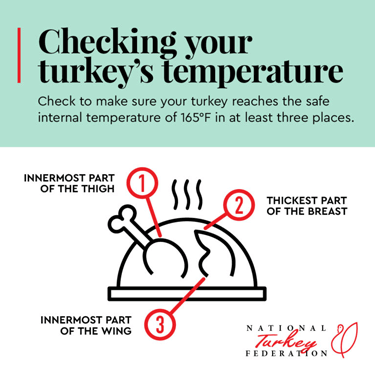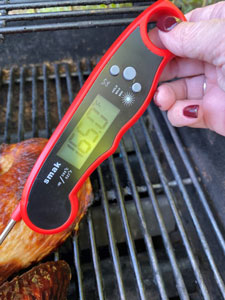Cooking a delicious and safe turkey is a culinary feat that many home cooks aspire to achieve. While the process may seem daunting, understanding proper thermometer placement in a turkey breast is crucial for ensuring both optimal results and food safety. This guide will delve into the essential aspects of thermometer placement, drawing insights from two authoritative sources:
- National Turkey Federation (NTF): This organization provides comprehensive information on turkey preparation and cooking, including guidelines for using thermometers.
- ThermoWorks: A leading provider of culinary thermometers, ThermoWorks offers detailed instructions and tips on accurate probe placement in turkeys.
Understanding Thermometer Placement:
1, Importance of Accurate Placement:
Precise thermometer placement is critical for obtaining an accurate reading of the turkey’s internal temperature. This ensures that the meat reaches a safe temperature of 165°F, eliminating the risk of foodborne illness. Additionally, proper placement helps achieve the desired level of doneness, preventing overcooking and dryness.
2. Key Considerations for Placement:
- Thermometer Type: The type of thermometer used influences the optimal placement. Oven-safe thermometers remain inserted throughout the cooking process, while instant-read thermometers are used for quick temperature checks.
- Target Temperature: For turkey breast, the target temperature is 165°F. However, it’s recommended to remove the turkey from the oven at 160°F to allow for carryover cooking, which will bring the temperature up to 165°F.
- Probe Location: The probe should be inserted into the thickest part of the turkey breast, avoiding bone. This ensures the thermometer accurately measures the internal temperature of the meat.
3. Step-by-Step Guide to Thermometer Placement:
a) Oven-Safe Thermometer:
- Insert the probe into the thickest part of the turkey breast, avoiding bone.
- Ensure the probe is inserted horizontally, with the tip about 1/2 to 1 inch from the internal cavity.
- Leave the thermometer in place throughout the cooking process.
b) Instant-Read Thermometer:
- Remove the turkey from the oven.
- Insert the probe into the thickest part of the turkey breast, avoiding bone.
- Ensure the probe is inserted horizontally, with the tip about 1/2 to 1 inch from the internal cavity.
- Wait for the reading to stabilize before checking the temperature.
- Repeat the process in different locations of the breast to confirm even cooking.
4. Additional Tips for Accurate Temperature Measurement:
- Calibrate your thermometer regularly to ensure accuracy.
- Use an ice-water bath or boiling water to test your thermometer’s calibration.
- Sanitize your thermometer before and after use to prevent cross-contamination.
- Consult the turkey’s cooking instructions for recommended cooking times and temperatures.
Following these guidelines for thermometer placement in a turkey breast will help you achieve a perfectly cooked, juicy, and safe turkey. Remember to use a reliable thermometer, insert it in the correct location, and monitor the temperature throughout the cooking process. With these steps, you can confidently prepare a delicious Thanksgiving turkey or any other turkey dish that will impress your family and friends.
Additional Resources:
- National Turkey Federation: https://www.eatturkey.org/thermometer-guidelines/
- ThermoWorks: https://blog.thermoworks.com/tips/accurate-probe-placement-in-turkeys/
Frequently Asked Questions:
1. Where is the thickest part of the turkey breast?
The thickest part of the turkey breast is typically located near the center of the breast, towards the back of the bird.
2. Can I use a pop-up thermometer instead of a regular thermometer?
While pop-up thermometers can provide an indication of doneness, they are not as accurate as traditional thermometers. It’s recommended to use a regular thermometer to confirm the internal temperature.
3. How long should I cook a turkey breast?
The cooking time for a turkey breast will vary depending on its size and cooking method. Consult the turkey’s cooking instructions or use a cooking time chart for guidance.
4. How do I know if my turkey is done?
The turkey is done when the internal temperature of the thickest part of the breast reaches 165°F.
5. Can I cook a turkey breast without a thermometer?
It is not recommended to cook a turkey breast without a thermometer. Using a thermometer ensures that the meat reaches a safe internal temperature and prevents overcooking.
Where to Put the Thermometer in a Turkey

Placing the thermometer correctly inside the turkey is crucial when using any type of thermometer. Here are some pointers to bear in mind if you’re not sure where to insert the thermometer in a turkey:
- Place the thermometer into the thickest part of the turkey breast, the innermost part of the thigh, and the innermost part of the wing when cooking an entire turkey.
- Ensure that the thermometer stays away from the pan, bone, or gristle.
- The thermometer should be inserted from the side into a ground turkey patty or turkey breast. Compared to when it is inserted from the top, the thermometer is more accurate and easier to read.
Your turkey (as well as any stuffing) should always be cooked to an internal temperature of 165°F.

According to the U. S. Food and Drug Administration reports that from 49% in 1998 to 70% in 2010, more consumers now own food thermometers. Utilizing a meat thermometer is advised by the USDA and the National Turkey Federation to guarantee a tasty and secure dinner.
For quality and safety reasons, it’s critical to maintain precise temperatures in both the oven and the turkey. When it comes to cooking, a meat thermometer is a cook’s best friend.
Our top picks are instant-read/digital meat thermometers and ones that can be calibrated for accuracy. You can get these kinds of thermometers at hardware, grocery, and kitchen stores.
Remember to check the oven’s temperature and thermostat to make sure the oven setting is correct. Adjust as needed; a 25°F difference can yield a 5 percent difference in cooked turkey yield. An overheated oven will cause the bird to dry out and shrink.
Check out USDA’s resource for more information on proper cooking temperatures.
This needs to be placed inside the turkey at the start of cooking and left inside the bird the entire time it is cooking. The temperature indicator will rise slowly as the turkey cooks. When it comes to the entire turkey and the turkey breast, an oven-proof thermometer is perfect.
With the help of these thermometers, you can quickly and accurately determine the internal temperature of meat. They are not intended to remain in the dish while it is cooking. If using this kind, remove the turkey from the oven just far enough to allow the stem to go about 2 1/2 inches into the thickest area of the meat without coming into contact with the roasting pan or the bone.
The tiny indentation that serves as the sensing tip is situated approximately 1 1/2 inches from the stem’s end and needs to be completely inserted into the bird. (Look for a tiny dimple on the stem. ) The temperature should register in about 15-20 seconds. Prior to and following each use, sanitize the area with a wipe.
Usually, the whole turkey and the turkey breast contain these. The turkey has reached the doneness and safety temperature when indicated by the “pop-up” thermometer. Experts suggest the temperature be verified with a conventional thermometer.
USDA has a full listing of the various types of food thermometers available.
After use, food thermometers should be cleaned and sanitized in hot, soapy water. The majority of thermometers, especially those that are digital and instant-read, shouldn’t be submerged in water.
There are several ways to sanitize your thermometer:
- Use an alcohol swab to wipe the stem.
- Utilize a food-safe disinfectant, like a mixture of water and chlorine bleach, diluted as per the bottle’s instructions, and immerse it in the diluted mixture for a minimum of 10 seconds.
- Submerge the stem into boiling water for a minimum of 30 seconds.
Make sure to wash the stem with soap and hot water after using alcohol or a cleaning solution to get rid of any residue.
